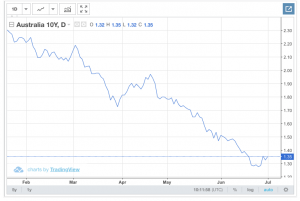The possibility of a rate cut from the Reserve Bank tomorrow and the usual start of month data for May on trade, building approvals, and retail sales will hold the attention of local markets at the start of the 2019-20 financial year.
A second rate cut is widely tipped from tomorrow’s Reserve Bank board meeting, the first monetary policy decision of the new financial year.
That will see the cash rate fall to a new all-time low of 1.00% and economists expect the central bank to maintain an easing bias.
The rate cut last month had no impact on the value of the dollar which has been more influenced by the trade war between China and the US and the move to an easing bias by the US Federal Reserve.
The Aussie dollar ended at 70.20 on Saturday morning – the highest since early May after which it slid to a five year low of 68.53 on June 17. The currency slid 5.2% against the greenback in the year to June, but ended up 1.25% for the month of June, thanks to the 1.24% appreciation last week.
The yield on the benchmark Australian 10-year bond rate almost halved over the year to June 28 – falling to 1.32% early Saturday morning, down 1.29% from the end of 2017-18.
The yield hit an all-time low of 1.27% last week.
Australia’s 10-year bond yield hits record low

(That makes you wonder about the future losses on bonds when yields eventually turn higher)
The RBA board meets in Darwin and Governor Philip will be speaking at a business dinner in the city tomorrow night with his remarks to be issued during the evening. They will amplify the post-meeting statement.
In his speech in Adelaide on June 20, Dr. Lowe made it clear the rate cuts so far were not having the desired impact:
“Monetary policy is one way of helping get us onto to a better path. The decision earlier this month will assist here. It will support the economy through its effect on the exchange rate, lowering the cost of finance and boosting disposable incomes. In turn, this will support employment growth and inflation consistent with the target,” Dr. Lowe said in his speech.
“It would, however, be unrealistic to expect that lowering interest rates by ¼ of a percentage point will materially shift the path we look to be on. The most recent data – including the GDP and labour market data – do not suggest we are making any inroads into the economy’s spare capacity.
“Given this, the possibility of lower interest rates remains on the table.
“It is not unrealistic to expect a further reduction in the cash rate as the Board seeks to wind back spare capacity in the economy and deliver inflation outcomes in line with the medium-term target.”
If for whatever reason there is no cut from tomorrow’s Darwin meeting, the August meeting will see it happen after the inflation data for the June quarter is released in the last week of this month.
The AMP’s Chief Economist, Dr. Shane Oliver wrote at the weekend:
“Of course, it’s a close call as to whether the RBA cuts on Tuesday or waits till August. But rate moves usually come in at least twos and the risks to the economic outlook have increased so it’s probably best to get another cut out of the way and then the RBA can sit back a bit and see whether it’s working.”
“Ultimately, we remain of the view that the RBA will then cut again to 0.75% around November and then to 0.5% around February next year.
Now that the RBA is cutting rates the importance of the month to month data has been reduced. Building approvals on Wednesday will show another fall, the trade data, also on Wednesday will show another big surplus, boosted by the high iron ore prices (which rose further in June).
The RBA reported on Friday that home lending credit data for the year to May fell again, as did personal credit, Growth now in mortgage lending is at the lowest rate for 40 years.
The surge in iron ore prices (around 82% for the financial year) will probably see a small surplus for the 2018-19 financial year – more than $4 billion better than forecast. That is actually contractionary, not the expansionary spending the RBA wants to see.
Thursday also sees the job vacancies for the three months to May for the Reserve Bank. Most economists are expecting a small fall after two years of rises.
Later today the house price data from CoreLogic for June, the month of June, the June quarter and the 2018-19 financial year will be released. Car sales data for June and the six months to the end of last month are due out later in the week.













